1863 CONFEDERATE CIVIL WAR SURGEON BATTLEFIELD RELIC Hanover VA Surgery BOOK

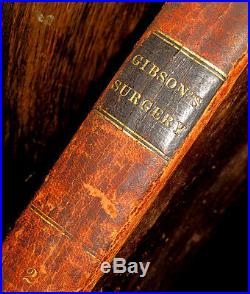
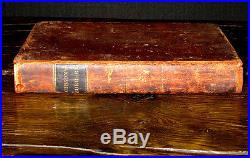

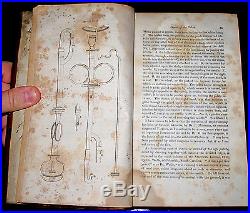
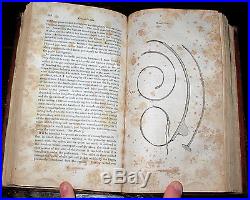

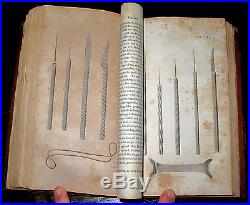
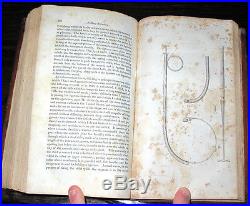
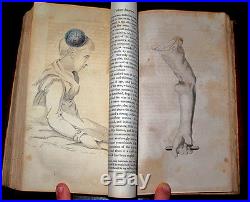
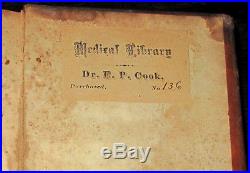
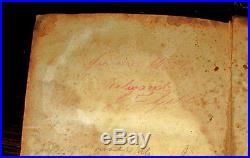

[CIVIL WAR BATTLEFIELD RELIC; CONFEDERATE SURGERY MANUAL OWNED BY 4TH TEXAS SOLDIERS AND SURGEON; BATTLE OF HANOVER FIELD RELIC CAPTURE BY UNION SOLDIER; MARINE HOSPITAL RELIC; COLOR PLATES]. The institutes and practice of surgery : being the outlines of a course of lectures. Philadelphia: Carey, Lean and Blanchard, 1835. Rare early nineteenth century book on surgery, "Being the Outlines of a Course of Lectures" by Dr.
Gibson - Professor of Surgery in the University of Pennsylvania, and Clinical Lecturer to the Alms-House Infirmary, &c. This nearly 200 year old surgery book has many full page plates (a few with hand colored enhancements); discusses Inflammation, Surgical Wounds, Abscesses, Ulcers, Scrofula, Cancer, Fractures, Luxations, Amputations, Caesarian Sections, and more. WHAT MAKES THIS BOOK UNIQUE IS THAT IT WAS ONCE HOUSED AT HANOVER COURT HOUSE IN VIRGINIA AND OWNED BY A CONFEDERATE SURGEON AND HIS COMRADES IN WHAT LOOKS TO BE THE 4TH TEXAS , THEN CAPTURED AND TAKEN BY A UNION SOLDIER AT THE BATTLE OF HANOVER AFTER THE UNION WIN IN JULY OF 1863, AND FINALLY PRESENTED TO A DOCTOR, WHO WAS ALSO A UNION CIVIL WAR VETERAN, TO THE CHICAGO MARINE HOSPITAL AFTER THE WAR IN 1867.
Original leather binding, extremities lightly worn with a few splits to the joints, hinges entirely intact, else fine with gilt rule and title label on the spine. Pages stained and worn with many water lines, ink smudges and a few pre Civil War medical annotations and marginalia. Lacks first 4 leaves, starts at page V of TOC. A few plates may be lacking, but many are retained and again a few are hand colored.
Measures roughly 9" x 5.5". On the front pastedown appears the following ink inscription: Taken at Hanover Court House July 63 by Maurice O'Sullivan 17th Reg. At Marine Hospital Chicago Ills.
Research shows that O'Sullivan was a private in the NY Vols, and was part of a few different regiments; 167th NY Vols and 11th NY Vols, and obviously, the 17th NY Vols, as he has inscribed. Although from Hanover Court House, this is certainly a relic taken by Maurice in the Battle of Hanover (which was active in early July of 1863), rather than the Battle of Hanover Courthouse which took place earlier in the War (May of 1862). What is most interesting is the results of researching the earlier signatures and bookplate found in the rear of the book. The bookplate was that of Dr.
E P Cook, from his medical library. There are two additional signatures back there as well, one of a James Martin and another of a J. When we searched these names, two of three (Cook and Gibbon) showed up as serving the 4th Texas, which was part of the Gettysburg Campaigns, and certainly was present at this particular Battle.
There are multiple records for a James Martin also serving the Confederacy with the Texas army, but none conclusively with the 4th. One could conclude that this was in fact carried and used by Cook in the War to perfrom surgical operations in the field, and, upon losing the battle at Hanover, perhaps abandoned the book or ceded it at that time, the time in which O'Sullivan gained its possession. See our research below, which we feel is fairly acceptable. A rare piece of Civil War Americana ; a truly unique and one of a kind ID'd battlefield relic with likely Confederate Texas surgeon ownership.
From Wikipedia, the free encyclopedia. Part of the American Civil War. "The Picket, " a commemorative statue in Hanover's Center Square; sculpted by Cyrus E. The Battle of Hanover took place on June 30, 1863, in Hanover.
In southwestern York County, Pennsylvania. As part of the Gettysburg Campaign. Of the American Civil War.Which was riding north to get around the Union. Attacked a Federal cavalry regiment. Driving it through the streets of Hanover. Arrived and counterattacked, routing the Confederate vanguard and nearly capturing Stuart himself. Farnsworth held his ground, and a stalemate ensued.
Stuart was forced to continue north and east to get around the Union cavalry, further delaying his attempt to rejoin Robert E. S army, which was then concentrating at Cashtown Gap. Lee moved his Army of Northern Virginia. Northward in June 1863 through the Shenandoah Valley.Portions of his cavalry under J. Stuart slipped eastward across the path of the Union Army of the Potomac.
A series of raids in eastern Maryland. Netted prisoners and supplies, as well as disrupting Federal communications and telegraph lines. However, Stuart was not in position to effectively screen Lee's advance or to provide intelligence on the movements of the Federal army. As Stuart headed north in an effort to link with Lee, Union cavalry commander Maj. Riding towards Pennsylvania to the west of Stuart, ordered his divisions.
To fan out across a wide swath, keeping an eye out for Confederates. S division was on the Union right flank.
The majority of his men passed through Hanover early in the morning of June 30, pausing briefly for refreshments and to receive the greetings of the jubilant townspeople. Their town had been raided three days before by Confederate Lt. S cavalry, attached to Maj. S division that had occupied York County.White's Virginians and Marylanders had followed the railroad to Hanover from nearby Gettysburg. White's raiders had destroyed the area's telegraph. Wires, cutting off communications with the outside world, before sacking the nearby Hanover Junction.
The unexpected arrival of Kilpatrick's column was a pleasant surprise to the residents of Hanover, who warmly greeted the Union troopers with food and drink. Most of Kilpatrick's men remounted and passed through town, heading northward through the nearby Pigeon Hills towards Abbottstown. He left behind a small rear guard force to picket the roads south and west of Hanover. In the meantime, Stuart had left his billet at Shriver's Corner, Maryland, and was proceeding northward across the MasonDixon line. Hearing that Federal cavalry had been spotted near his intended destination, Littlestown, Pennsylvania.
He instead turned towards Hanover in adjacent York County. His progress was slowed considerably by a cumbersome train of over 125 heavily laden supply wagons that he had captured near Rockville, Maryland. In addition, he had skirmished with Delaware cavalry on June 29 at Westminster, Maryland. Map of Hanover Battlefield core and study areas by the American Battlefield Protection Program. Shortly before 10:00 a.
On June 30, the rear guard of the 18th Pennsylvania Cavalry encountered Confederate videttes about three miles (5 km) southwest of Hanover at Gitt's Mill. Shortly afterwards, 25 men from Company G of the 18th Pennsylvania were captured by the 13th Virginia. S brigade, the vanguard of Stuart's oncoming cavalry. Also that morning, a series of minor engagements occurred near Littlestown and elsewhere along Stuart's path. Southwest of Hanover at a tiny hamlet now known as Pennville. The 2nd North Carolina Cavalry struck the 18th Pennsylvanias main column and split it in two. Union survivors retired in disorder through the streets of Hanover just as Stuart's horse artillery. Arrived, unlimbered, and opened fire. As the Confederates occupied the town in the wake of the fleeing Pennsylvanians, General Farnsworth wheeled the 5th New York Cavalry into position near the town commons and attacked the Rebel flank in the streets, forcing the Tar Heels. To abandon their brief hold on the town.The commander of the 2nd North Carolina, William Henry Fitzhugh Payne. Was captured after his dying horse pitched him into a nearby tanning vat. A Union soldier pulled Payne out and took him prisoner. As more of Chambliss's men (and General Stuart) arrived on the scene, they were met by additional Federals near the sprawling Karle Forney farm, just south of Hanover.
Nearly surrounded in the confused fighting, Stuart and a staff officer made their escape cross-country through the hedges bordering the country lane, at one point leaping their horses over a 15-foot (4.6 m) wide ditch. Hearing the unmistakable sound of distant gunfire, Judson Kilpatrick raced southward towards Hanover, with his horse dying in the town square from the severe ride.
The young general began to deploy his men in and around Hanover, barricading some streets with barrels, farm wagons, dry goods boxes, and anything else that might provide cover. Shortly before noon, fighting at the Forney farm ceased as the Rebels broke off contact.
Kilpatrick positioned Custer's newly arrived brigade on the farm and awaited developments. S Virginia brigade arrived, Stuart moved his and Chambliss's men into a new position on a ridge extending from the Keller Farm southwest of Hanover to Mount Olivet Cemetery southeast of town. Meantime, Kilpatrick repositioned the brigades of the newly promoted duo of Custer and Farnsworth to form a better defensive perimeter and then brought up his guns. Leaving the captured wagons two miles (3 km) south of town under heavy guard, Wade Hampton. Brought his brigade and Breathed's Battery into position near the Mount Olivet Cemetery on the extreme right of Stuart's line.
An artillery duel ensued for the better part of two hours as opposing cannons hurtled shells over the town. Fragments blasted holes in several houses and narrowly missed killing Mrs. Henry Winebrenner and her daughter, who had just left their balcony when a projectile came hurtling through the upstairs.
Moved forward to within 300 yards (270 m) of Chambliss and the two guns supporting his line. Flanked and losing fifteen men as prisoners, the Wolverines tried again and succeeded in securing the Littlestown-Frederick Road, opening a line of communication with the Union XII Corps. Stuart and Kilpatrick made no further aggressive moves, and both sides initiated a series of skirmishes and minor probing actions. Disengaging slowly and protecting his captured wagons, Stuart withdrew to the northeast through Jefferson.
Known from recent newspapers to be the location of Early's division. En route, Stuart heard at New Salem. That Early's Division had recently left York and marched northwestly through Dover. Stuart changed course and headed northward through the night on winding, hilly country roads, still trying to locate Early or Lt. Thinking the latter still to be towards the Susquehanna River. The head of Stuart's seventeen-mile (27 km) long column arrived in Dover at 2:00 a. On the morning of July 1, with the rear guard there by 8:00 a. Stuart learned that Early had passed through town and was heading westward towards Shippensburg. Stuart paroled over 200 Union prisoners and gave his troopers a much needed six-hour rest while, unknown to Stuart, Maj. S Confederate infantry division collided with Brig.S Union cavalry at Gettysburg. Stuart resumed his exhausting march through the afternoon and early evening, seizing over 1,000 fresh horses from York County farmers. Leaving Hampton's Brigade and the wagons at Dillsburg. Instead, Stuart found nearly 3,000 Pennsylvania and New York militia. After lobbing a few shells into town during the early evening and burning the Carlisle Barracks.
Stuart withdrew after midnight to the south towards Gettysburg see Skirmish at Carlisle. The fighting at Hanover, the long march through York County with the captured wagons, and the brief encounter at Carlisle slowed Stuart considerably in his attempt to rejoin the main army and locate Lee.The "eyes and ears" of the Army of Northern Virginia had failed Lee. Losses at Hanover were relatively light in terms of casualties, but the cost in time in delaying Stuart from linking with Lee proved to be even more costly. Estimates vary as to the number of men lost at Hanover; Union losses in one source are listed as 19 killed, 73 wounded, and 123 missing (for a total of 215). The 18th Pennsylvania had suffered the most, with three men killed, 24 wounded, and 57 missing. On the Confederate side, Stuart's losses are generally estimated as 9 dead, 50 wounded, and 58 missing, for a total of 117.
The fighting in Hanover is commemorated by "The Picket, " an impressive bronze statue of a mounted cavalryman sculpted by famed Boston artist Cyrus E. Paid for by the state of Pennsylvania, it was erected in 1905 in the center square. Two bronze plaques installed by the Federal government in 1901 bear inscriptions relating to the movements of the Army of the Potomac on June 30 and July 1, 1863. In addition, a small number of artillery pieces are located on the town's square, including serial number 1 of the Parrott Rifle.
The original barrel, mounted on a reproduction carriage. A wall plaque on a modern building and a star surrounded by four horseshoes installed in the sidewalk mark the location of Custer's headquarters and the "Custer Maple, " a prominent tree used by the boy general to tether his horse. In 2005, the borough erected over a dozen wayside markers at key spots along the city streets to help interpret the battle for visitors, and three years later the state added its own markers as part of the Pennsylvania Civil War Trails initiative. However, much of the open area south of town, including the Forney farm where Custer advanced, has been lost to modern development, as has the once open hills a half-mile north of Hanover Center Square where Kilpatrick's artillery deployed. Elder's Battery of four cannons was deployed along what is now Stock Street east of Carlisle Street and Pennington's Battery was deployed along what is now 4th Street west of Carlisle Street.The York County Heritage Trust. And some local Hanover organizations sponsor guided tours of the battle sites. 162nd Regiment, New York Infantry. 11th Regiment, New York Infantry.
Ralph was born in Wilmington, Delaware, September 25, 1841, and received a common school education there, and later at Mendota, Illinois, to which he removed with his parents in 1857. In 1862 he enlisted in an Illinois regiment and was assigned to duty as Assistant Hospital Steward, where he began the study of medicine.
At the close of the war he entered the Marine Hospital, at Chicago, as a student, and graduated at Rush Medical College in 1867. Began practice at Mendota and about a year later removed to Sterling, Illinois, where he continued to practice his profession until 1882, when he came to Omaha and established himself in a successful practice here. In May, 1887, he was appointed City Physician by Mayor Broatch and confirmed by the council, becoming, by virtue of that office, Secretary of the Board of Health. Ralph is a member of the Nebraska State Medical Society and also of the Douglas County Medical Society, and is esteemed to be one of our most reputable physicians, the result of conscientious and untiring devotion to his profession, the complete mastery of which stimulates his greatest ambition. Considering the comparatively short time he has been located in Omaha, Dr.
Ralph has attained a position of prominence in the profession seldom reached; and his calls take him among every class of the community. 4th Infantry Regiment completed its organization at Richmond, Virginia. Its members were recruited in the counties of Goliad, Travis, Robertson, Falls, Guadalupe, McLennan, Bexar, Grimes, Walker, Hill, Montgomery, Freestone, Navarro, Ellis, and Henderson. It became part of Hood's Texas Brigade and served under Generals Hood, J.
The 4th participated in the campaigns of the Army of Northern Virginia from Seven Pines. Except when it was with Longstreet at Suffolk. It continued the fight in the Petersburg.
Trenches north and south of the James River and in various conflicts around Appomattox. The regiment had 470 effectives in April, 1862 and lost fifty-four percent of the 200 engaged at Sharpsburg.
And more than twenty-five percent of the 415 at Gettysburg. On April 9, 1865, it surrendered 15 officers and 145 men. The field officers were Colonels John P.
Key, and John Marshall; Lieutenant Colonels Benjamin F. Carter, Bradfute Warwick, and Clinton M. Winkler; and Majors William H.
The item "1863 CONFEDERATE CIVIL WAR SURGEON BATTLEFIELD RELIC Hanover VA Surgery BOOK" is in sale since Friday, June 30, 2017. This item is in the category "Books\Antiquarian & Collectible". The seller is "mantosilver" and is located in Spencerport, New York. This item can be shipped worldwide.- Binding: Leather
- Subject: Military & War
- Topic: Civil War (1861-65)
- Special Attributes: Illustrated
- Origin: American
- Year Printed: 1835
- Printing Year: 1835
- Language: English
